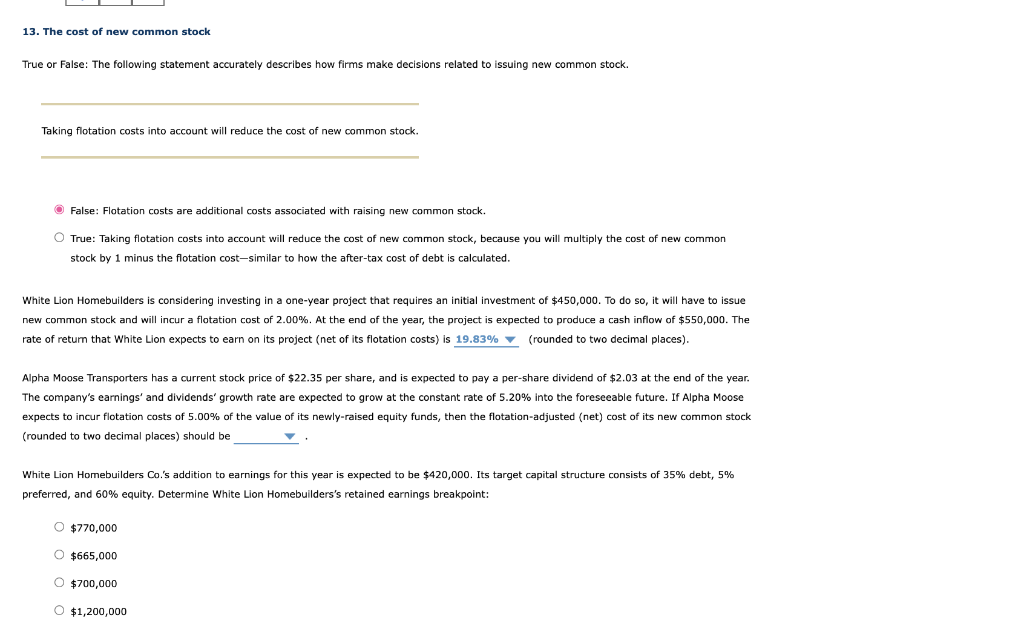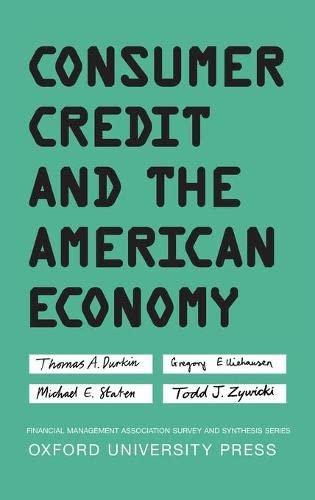please answer both questions and label them


13. The cost of new common stock True or False: The following statement accurately describes how firms make decisions related to issuing new common stock. Taking flotation costs into account will reduce the cost of new common stock. False: Flotation costs are additional costs associated with raising new common stock. True: Taking flotation costs into account will reduce the cost of new common stock, because you will multiply the cost of new common stock by 1 minus the flotation cost-similar to how the after-tax cost of debt is calculated. White Lion Homebuilders is considering investing in a one-year project that requires an initial investment of $450,000. To do so, it will have to issue new common stock and will incur a flotation cost of 2.00%. At the end of the year, the project is expected to produce a cash inflow of $550,000. The rate of return that White Lion expects to earn on its project (net of its flotation costs) is 19.83% (rounded to two decimal places). Alpha Moose Transporters has a current stock price of $22.35 per share, and is expected to pay a per-share dividend of $2.03 at the end of the year. The company's earnings' and dividends' growth rate are expected to grow at the constant rate of 5.20% into the foreseeable future. If Alpha Moose expects to incur flotation costs of 5.00% of the value of its newly-raised equity funds, then the flotation-adjusted (net) cost of its new common stock (rounded to two decimal places) should be White Lion Homebuilders Co.'s addition to earnings for this year is expected to be $420,000. Its target capital structure consists of 35% debt, 5% preferred, and 60% equity. Determine White Lion Homebuilders's retained earnings breakpoint: O $770,000 O $665,000 O $700,000 $1,200,000 14. Solving for the WACC The WACC is used as the discount rate to evaluate various capital budgeting projects. However, it is important to realize that the WACC is an appropriate discount rate only for a project of average risk. Analyze the cost of capital situations of the following company cases, and answer the specific questions that finance professionals need to address. Consider the case of Turnbull Co. 58% debt, 6% preferred stock, and 36% common equity. It has a before-tax cost of debt of 11.1%, and Turnbull Co. has a target capital structure its cost of preferred stock is 12.2%. If Turnbull can raise all of its equity capital from retained earnings, its cost of common equity will be 14.7%. However, if it is necessary to raise new common equity, it will carry a cost of 16.8%. If its current tax rate is 25%, how much higher will Turnbull's weighted average cost of capital (WACC) be if it has to raise additional common equity capital by issuing new common stock instead of raising the funds through retained earnings? (Note: Round your intermediate calculations to two decimal places.) O 1.03% O 0.68% O 0.91% 0.76% Turnbull Co. is considering a project that requires an initial investment of $270,000. The firm will raise the $270,000 in capital by issuing $100,000 of debt at a before-tax cost of 10.2%, $30,000 of preferred stock at a cost of 11.4%, and $140,000 of equity at a cost of 14.3%. The firm faces a tax rate of 25%. What will be the WACC for this project? (Note: Round your intermediate calculations to three decimal places.) Consider the case of Kuhn Co. Kuhn Co. is considering a new project that will require an initial investment of $4 million. It has a target capital structure of 45% debt, 4% preferred stock, and 51% common equity. Kuhn has noncallable bonds outstanding that mature in five years with a face value of $1,000, an annual coupon rate of 10%, and a market price of $1,050.76. The yield on the company's current bonds is a good approximation of the yield on any new bonds that it issues. The company can sell shares of preferred stock that pay an annual dividend of $8 at price of $95.70 per share. Kuhn does not have any retained earnings available to finance this project, so the firm will have to issue new common stock to help fund it. Its common stock is currently selling for $22.35 per share, and it is expected to pay a dividend of $2.78 at the end of next year. Flotation costs will represent 3% of the funds raised by issuing new common stock. The company is projected to grow at a constant rate of 8.7%, and they face a tax rate of 25%. What will be the WACC for this project? (Note: Round your intermediate calculations to two decimal places.)








